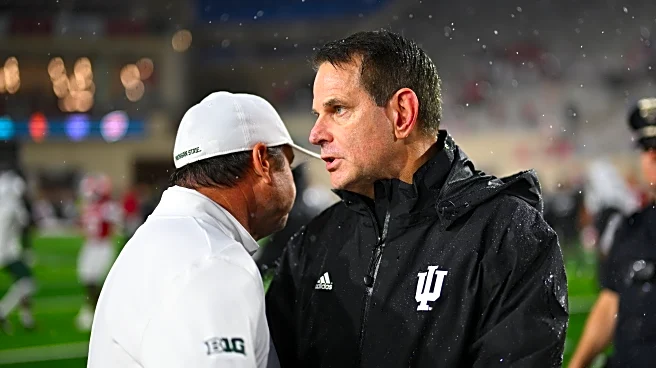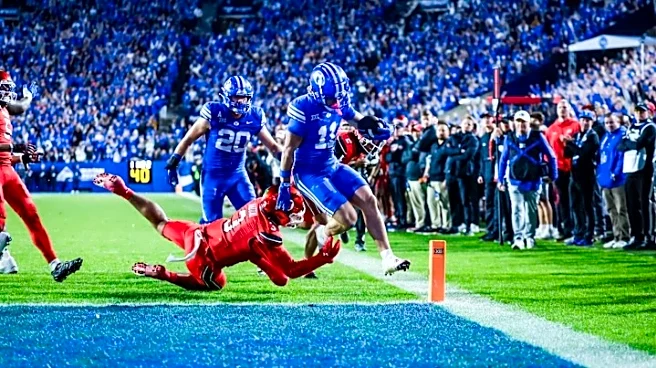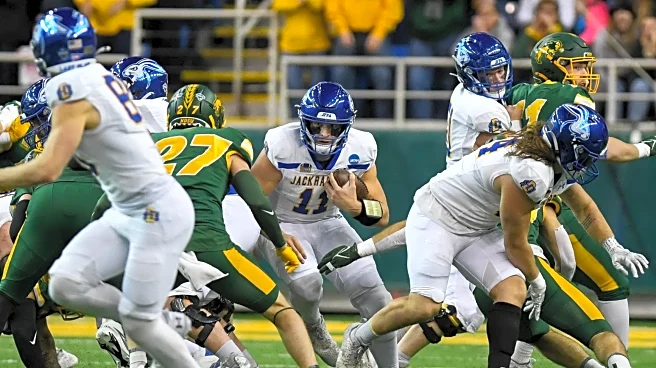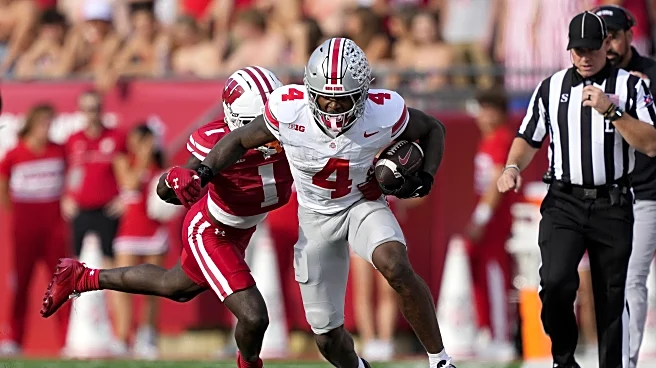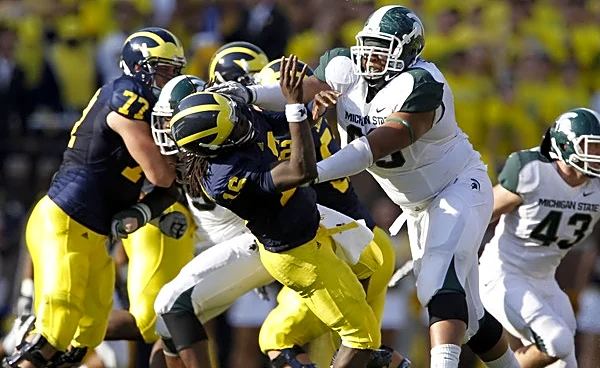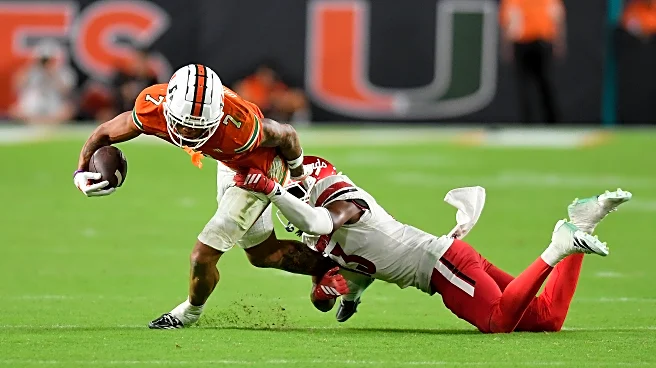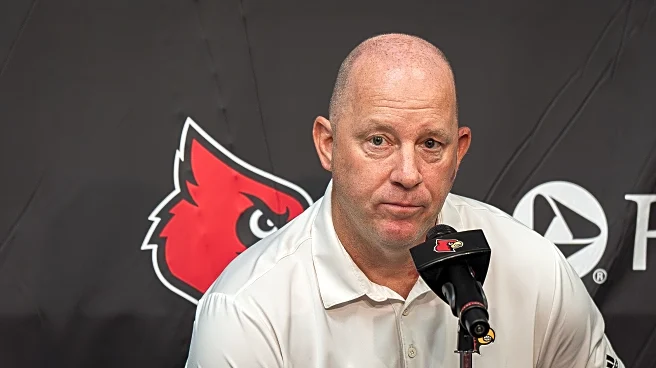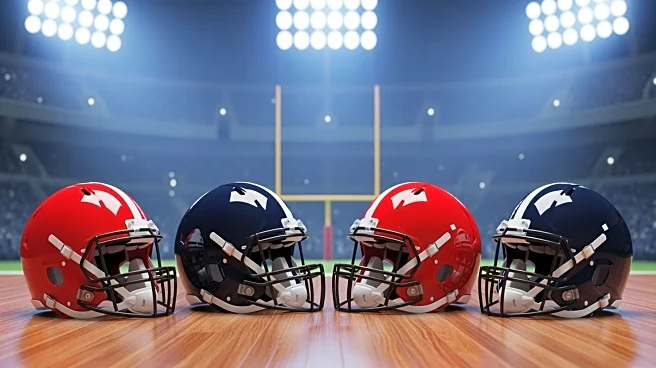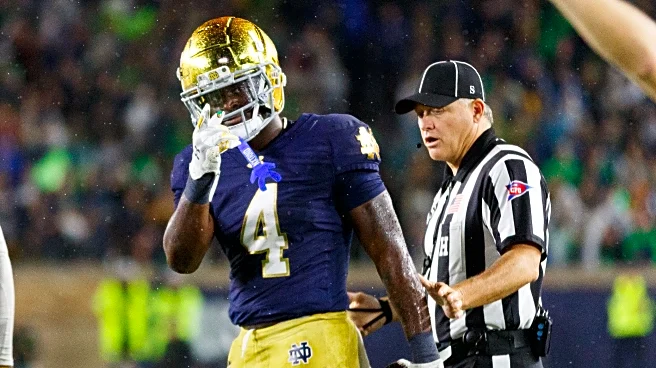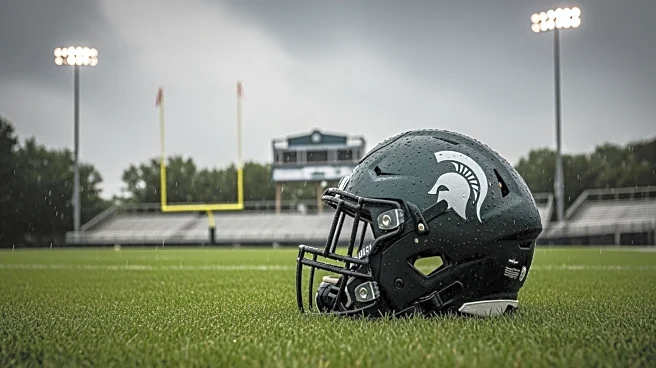Back for more? Props to you for sticking with this team. This past weekend delivered the 2025 Michigan State squad another loss against a ranked team, as Jonathan Smith still is yet to lead the Spartans
to victory against a top-25 opponent. This brings State’s record to 3-4 with a rivalry matchup with that school down the road looming large this coming Saturday. Let’s see what we can learn by breaking down the film from MSU’s 38-13 loss to the (newly #2 team in the country) Indiana Hoosiers.
Offense
367 total yards, 31:14 time of possession to Indiana’s 28:46, but only able to put up 13 points. How about we let starting quarterback Aidan Chiles break down that performance: “[The offense] played well. We didn’t execute as well as we should have. We didn’t finish in the red zone. We didn’t finish drives, but at the end of the day I think we played great.”
Not sure if I would call it a great showing, but the offense certainly outperformed their counterparts on the other side of the ball. A closer look at those 367 yards reveals that 291, or 79%, can be attributed to the all-purpose yards of Chiles (243 through the air and 48 on the ground). The way Aidan responded to doubters after a couple subpar outings against Nebraska and UCLA is definitely a positive takeaway. Flying more under-the-radar, the way Offensive Coordinator Brian Lindgren answered the bell, especially with playcall early on, was equally impressive. The first half Spartan offense was able to consistently move the ball against a rock-solid Indiana defense, and importantly, keep the high-powered Hoosier offense (and low-powered MSU defense) on the sideline.
One of my favorite Lindgren playcalls was his consistent utilization of inside-breaking pass concepts that MSU took advantage of against the often-outside leveraged Indiana cornerbacks. The first instance was on State’s opening drive, staring down their first 3rd down of the game, the first down marker 13 yards away.

Pre-snap, up above, Indiana looks to be in a Cover 4, or “Quarters” look, where each cornerback and safety will be responsible for ¼ of the field in pass coverage. IU also has both of its middle linebackers “mugging”- or showing blitz- one in the left side “A” gap (left of the center) and the other in the right side “B” gap (right of the RG). The good news? The Spartans have both TE Michael Masunas and RB Makhi Frazier in the backfield, making 7 to pass protect against Indiana’s 6.
This is all just a disguise. Upon the snap, Indiana changes its look to a “Tampa 2” coverage, wherein the cornerbacks will play outside leverage and now be responsible for any short threats outside to the flat, only gaining depth if there is no flat threat. Both high safeties will be responsible for halves of the field, similar to in a normal cover 2. Additionally, both “mugging” inside linebackers bail out, responsible for the “hook/curl area” which refers to first covering the “hook” zone just inside the hashes, before backing up further into the “curl” seam further downfield and outside. Finally, IU’s nickelback, who is aligned well off the ball at 7 yards presnap, is the “deep-hole dropper”, which is exactly what it sounds like. He has to retreat, and fast, to cover the deep middle of the field that is vacated by the safeties booking it to either half of the field. That’s a lot to digest. Here it is in visual form:

Pretty complicated stuff here. Thankfully, the play that OC Lindgren has called is perfect to attack any look with outside leveraged cornerbacks, so Indiana’s disguised Tampa 2 does not worry Chiles and company at all. The route combination drawn up below is referred to as a “dagger” concept, where the inside receiver (Chrishon McCray) will be running a “clearout” route, opening up the middle of the field for the outside WR (Omari Kelly) to run a deep “dig” or “in” route at about 15 yards.

Now, remember Indiana’s defensive call. The deep hole defender (nickelback) will be forced to follow McCray up the middle of the field, and the hook/curl defenders (both mugging LBs) have an extra long way to go to cover their zones. Also recall that the corner opposite Kelly will primarily be responsible for the flat. Once he realizes MSU is not sending any pass-catchers to the flat, he will maintain outside leverage as he mirrors Omari’s route vertically. What does all this mean? There should be a huge window for Chiles to make an accurate throw to Kelly and move the chains. Lindgren has schemed himself a first down with the perfect counter to IU’s Tampa 2 coverage.

Below is the same play from an inside camera angle. Pay special attention to the deep hole dropper following McCray up the field and the cornerback’s outside leverage. Also see LB #4, who is responsible for the hook/curl to Omari’s side, be unable to drop back far enough into coverage, due to his pre-snap alignment, to disrupt this throw.

If it ain’t broke, don’t fix it, right? Next time the MSU offense called upon a dagger concept was on a 1st and 10, now trailing 14-10 on its third offensive possession of the game. This time, the Spartans only release two wideouts into the pattern, but also use play action in order to influence Indiana’s second-level defenders. Check it out drawn up below.

As you can see with the red circles, IU’s secondary is in a cover 3 look, where it will divide the field into deep thirds, and allow the linebackers to play any shorter, underneath routes. As you also (hopefully) picked up on, both cornerbacks are yet again outside leverage. Once again, the in-breaking dig route from Omari Kelly takes advantage of this alignment. Thanks to a good play-action fake from Chiles and Frazier, the hook/curl defenders are late to the party, and the middle high safety gets so much depth that he is not a concern for Kelly’s dig. No, it isn’t deja vu, just the Spartans executing on a similar play style twice.

Another in-breaking pass concept that MSU made their money’s worth on was simple slant-flat patterns. Call to mind the Chiles→Marsh TD that put the Spartans ahead 10-7 early in the game. This is exactly the type of short/intermediate passes that utilize State’s best outside weapon that Spartan Nation has been clamoring for.

By now, you should be able to identify what kind of leverage IU’s boundary CB is playing. With him outside, Lindgren dials up a quick slant from Marsh, assisted by a quick flat route, or “arrow” from RB Makhi Frazier. This combination gives Aidan Chiles an easy “inside/out” read, where he first looks to the arrow route, manipulating the defense, before snapping across an accurate pass to Marsh that hits him right on the money. Watch below as IU’s outside leverage corner is already in a tough position to cover an in-breaking route, but gets even more out of position when Chiles looks to Frazier first. His hesitation creates a huge seam for Nick Marsh, and the sophomore sensation does the rest.

Below see it from the inside view. In this replay, pay attention to how Chiles’ shoulders and eyes both go to Frazier first, and how aggressively the Indiana corner and safety react to this. Nuance like this is a sign of Aidan’s maturity, and certainly something positive to take away, even in a brutal 25 point loss.

One final tip of the cap I will give to Lindgren’s offense from Saturday is in the screen pass game. The playcaller finally is starting to play off of MSU’s gross ineffectiveness in the zone run game, and against IU, that came in the form of screen passes. As this season has rolled along, we have time and time seen Spartan ballcarriers stuffed for a loss behind the line of scrimmage, the offensive line getting overpowered and shoved into the offensive backfield. This was no different against the Hoosiers, as Indiana held Michigan State to a horrifying 20 (yes, 20) yards on the ground by all combined running backs. However, to Lindgren’s credit, we did see Elijah Tau-Tolliver, Makhi Frazier, and Brandon Tullis combine for 56 receiving yards. How? Screen passes.

Above, MSU is just inside IU territory, looking at a first and ten. How many times have we seen unsuccessful run plays out of this two-tight end formation? Too many to count. Indiana’s defensive line had generated a great deal of push up front, and gotten into the backfield several times to this point in the game. Lindgren and company take advantage of that Hoosier aggressiveness.

This is a two-man play action screen. While Chiles fakes the run action to Tau-Tolliver, Spartan Left Guard and Center will set for a quick two or three second count, then let their men into the backfield, and release to the next level. The Right Guard is what is known as the “Rat Killer”, who also will release, but rather than go upfield, he will loop back to the line of scrimmage, preventing any defensive linemen who sniff out the screen to chase down his RB from behind. Watch it develop below.

The Spartan offense knows that Indiana’s D-Line has already gotten into the backfield a number of times on run plays, and will not realize anything is out of the ordinary until it is too late, and the ball is dumped off over their heads. I love this playcall, and love the chunk yardage that comes with it. E T-T makes the grab with blockers out in front of him, and gets to the 25 yard line of IU, setting up the aforementioned Marsh touchdown.
Now, to a playcall that I don’t love nearly as much. Actually, one that I despise. To this point, this article has probably been much more positive than you expected. That is because I genuinely agre with a lot of the concepts Lindgren had called in the pass game throughout this matchup. That ends here. You would think that with such an effective screen game, so much success on in-breaking pass concepts on key downs, and even positive yardage in the QB run game, that Brian Lindgren would have a great wrinkle on his call sheet for the most important third down of the game. Right? Wrong.
It’s 10–14, Indiana in front, late in the first half with under four minutes remaining. After completions of 23 and 8 yards, Michigan State is moving the ball once again. With the Spartan defense yet to stop the Hoosier offense, this drive is crucial. State needs to come away with points to cut into or even take the lead, and leave as little time as possible before halftime, when Indiana will receive the second-half kickoff.

Rather than put the ball in the hands of your athletic QB or talented wideouts, MSU chooses to rely on its unreliable Offensive Line and calls an outside zone to the short side of the field. In fact, both of State’s leading wide receivers, Nick Marsh and Omari Kelly, are not even on the field. If there’s ever been a head scratching, face palming, head shaking playcall, from the Spartan offense, this is it. I completely understand if you don’t want to rewatch this play, but I have provided it below anyway.

Both Right Guard and Right Tackle continue the trend of pitiful run blocking, and get beat. Badly. Reserve WR Rod Bullard, to the boundary, gets beat as well, and this play has no chance. To make matters worse, instead of going for it on the ensuing 4th down, or even trying to pin Indiana deep with the All-American punter in Ryan Eckley, State chooses to quick punt with Aidan Chiles. Before you know it, it’s 21–10 Hoosiers. After halftime: 28–10. One questionable playcall snowballed into a series of unfortunate events for our Spartans, and Indiana ran away with this one.
It all started with this 3rd and 7. With MSU’s current defensive situation, I would have loved to see a more aggressive playcall, or at least a timeout to reconsider the plan. This is the problem I have with Coach Lindgren. In his time at MSU, for the most part, he has come out with solid scripted drives to start the game. Good play design, and a clear understanding of his team’s strengths and the opponent’s weaknesses. However, when push comes to shove, his decision making at crucial points is questionable, at best. I don’t know how much of these struggles with key play decision making are to blame on the OC versus Jonathan Smith, but regardless, if State wants to reverse the trend of crumbling in the biggest moments, a change is going to have to be made.
Defense
Where to begin. It feels like every single issue we have discussed with the defense over the course of the season was on full display for any paying Peacock customer this Saturday at noon.
We might as well take a look at Indiana’s first touchdown for a great example of the defensive dysfunction.

IU has a “spot” concept drawn up, which is defined as a play with a flat route, a quick hook route, and a corner route up top. However, IU runs “spot” with a couple added wrinkles. The first is a motion from the boundary WR, who crosses the field and becomes the “arrow” route to the flat on the opposite side. Additionally, QB Fernando Mendoza will be rolling out to the field, putting immidiate pressure on the defensive backfield to not only defend each route, but also the threat of a QB run on third and short.
I wish I could draw up the coverage Michigan State is in here, but I genuinely cannot decipher what the call from DC Joe Rossi is. The boundary corner, Josh Eaton, initially follows the motion, suggesting man coverage. However, he retreats just before the snap, and the field corner Malcolm Bell slow-plays his coverage at the snap in a clear zone look. Coach Rossi- what’s going on here?

Likely a miscommunication. Watch above as Bell and safety Armorion Smith play a zone coverage against the spot concept, but #28 Dontavius Nash plays man-to-man on IU’s flat route from #3. Jordan Hall also thinks it is a man coverage, following the Hoosier running back as he rolls out with Mendoza. This confusion allows for an easy pitch and catch, with plenty of room for yards after the catch and a TD to take the lead.
If the most vital play of the game in the earlygoing for the MSU offense was the 3rd and 7 run call, the most crucial for the defense is this next play, midway through the 2nd Quarter.

After a rare TFL by the Spartan D, Indiana is faced with a 2nd and very long, and things are looking up for State to get its first defensive stop of the day. Rossi calls an split-field coverage, where the defenders towards the top of your screen are in a man look, on both of the IU wide receivers. To the bottom, State is in a cover 2 zone, where Malcolm Bell will have the flat, and Malik Spencer will have any deep routes to the boundary. Both inside LBs will be playing their respective side of the field’s hook/curl zones. Check it out below.

The Hoosier playcall? Mendoza will have a curl/flat concept to the field, where his TE will release late to the flat, and his widest WR to the field will cut inside and settle, looking to find a window versus zone coverage.

This is good news for Michigan State, as curl/flat combinations are more effective against a zone, and they are in a matchup man-to-man to the field. Josh Eaton, who is pressed on the line of scrimmage pre-snap, does a great job of “jamming” his man and disrupting the curl route. Armorion Smith, at Strong Safety, covers the slot WR’s vertical route well. The MSU front even generates pressure. Mendoza is forced to step up and check the ball down to his Tight End in the flat. Dontavius Nash is in perfect position to make a tackle and force 3rd and 10+… and he completely whiffs. A brutal physical mistake that kills a well-executed concept, and IU is off to the races for a big gain.

These two plays show similar themes that we have revisited time and time again in this series. Miscommunications, which have been caused by everything from inexperience and injuries to loud away games, from making checks to missing calls. Missed assignments and missed tackles that make bad plays worse, and an overall lack of playing together on the defensive side of the ball.
In terms of scheme, I am somewhat disappointed. A couple of weeks ago, I gave DC Joe Rossi credit for using unique pressures to generate QB hurries against Nebraska, and we saw how that limited a talented quarterback in Dylan Raiola. Upon rewatch, MSU tried to mimic a similar gameplan, but two things were different. First off, Indiana made a lot of their money on RPOs, or run-pass-options, where the offensive line blocks for a run play, but the QB has an option to throw a quick pass to the outside. The fear of having to quickly reverse course and pursue a pass route definitely slowed down the Spartan pass rush. Additionally, State’s blitzes, more often than not, were accompanied with off-coverage from the defensive backs. This allowed Mendoza to time and time again dink-and-dunk, or find his quick outlets to avoid sacks and negative plays. Our final play exhibits both of these themes.

While it is only recorded as a gain of 6 or 7 yards in the scorebook, it tells us so much about both of these teams. MSU, a struggling defense in every sense of the word, keeps eight defenders in the box to play the run, and still gets pushed backwards. MSU, not trusting its’ young secondary, plays conservative, giving the Hoosier WRs a big cushion. Indiana, an offense firing on all cylinders and looking for a College Football Playoff berth, is outnumbered in the box, but still opens a hole for the running back. Indiana, trusting its veteran QB, allows Mendoza to make a good play even better, by getting the ball out quick for a substantial gain, setting up yet another touchdown drive. Little things like this, on seemingly unimportant plays, can sometimes tell the whole story.
Takeaways and Looking Forward
Definitely an offense-heavy edition of The Film Room for you all today. Not only is this for the sake of my mental health, but also to recognize that there are some positives for the 2025 MSU football team. Chiles is vastly improved from a year ago, Marsh, Kelly, and McCray are legit weapons, and both TEs and running backs have given good effort. You have to feel bad for these kids who show up and work hard, despite being in the midst of one of the darkest stretches of Spartan football in recent memory.
As we discussed; early, scripted offensive drives have given us Spartan fans a glimpse of what could be a dynamic offense, but time and time again we have seen a late-game decline. As the clock ticks on, playcall grows uninspired, effort wanes, and execution crumbles. On the defensive side, flashes have been much more brief. Injuries and depth problems have led to a ragtag group who can’t seem to measure up to the tough Big Ten slate.
At the end of the day, Indiana didn’t just out-talent the Spartans. They out-coached, out-communicated, and out-executed the green and white. How? Consistency. In all aspects. IU is a program, similarly in their second year under a new Head Coach, but somehow could not be further from MSU in terms of on field production. Curt Cignetti has ushered in an era of Indiana football that has completely revolutionized the culture, fanbase, and reputation that the traditional basketball school has on the national level. Jonathan Smith has seemingly sat idly by as Michigan State football descends into college football obscurity.
Why is there this gap between Michigan State and Indiana? Just like I discussed last week, I believe the answer is culture. A team’s attitude reflects the personality of its’ Head Coach. That is why the Hoosiers play like a fiery, inspired, no-nonsense unit. And that is why I have no idea what the identity of Michigan State football is. Coach Smith, through 19 games in East Lansing, has yet to show even a sliver of personality, good or bad. What I wouldn’t give for a fanbase-rallying, team-inspiring, and emotion-provoking Mark Dantonio press conference right about now.
Speaking of Coach D, we all know what week it is now. We all know what team is next on the schedule. As much as I want to give up on the Smith era here at Michigan State, the California native has another massive opportunity this coming Saturday, at home versus that team down the road. If there is any semblance of a winning culture and identity at MSU, any hope for Jonathan Smith to save his job, and any chance at turning this season around, it has to come under the bright lights of Spartan Stadium. As a great man once said: “It’s not over. It’ll never be over here.” No matter MSU’s record to this point. No matter rankings, spreads, or expectations. It is time to bring Paul Bunyan home. Go Green.

